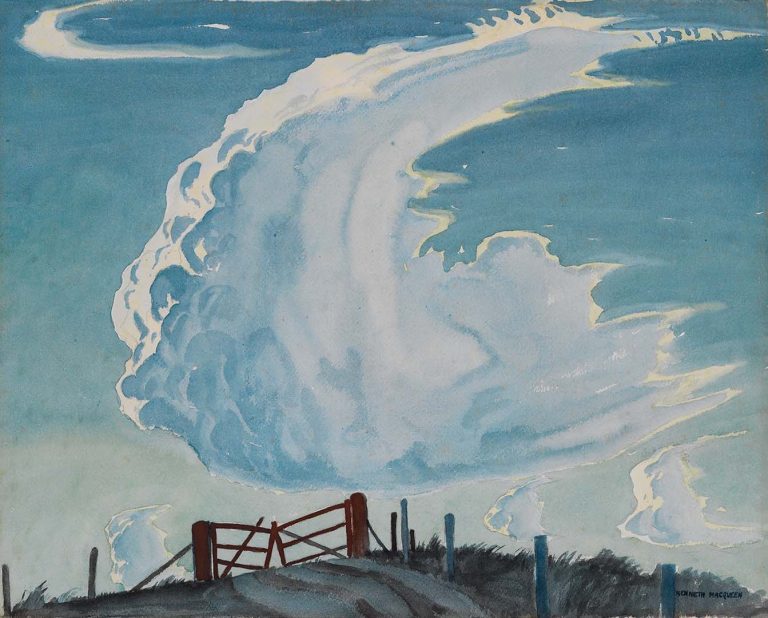We acknowledge the Traditional Owners of the land on which the Queensland Art Gallery | Gallery of Modern Art stands and recognise the creative contribution First Australians make to the art and culture of this country.

Kenneth Macqueen / Australia 1897–1960 / (Flying cloud) c.1950 / Watercolour over pencil / 38 x 47.7cm / Purchased 1999 with funds from National Australia Bank Limited through the Queensland Art Gallery Foundation / Collection: Queensland Art Gallery | Gallery of Modern Art / © Kenneth Macqueen Estate
Kenneth Macqueen(Flying cloud) c.1950
Not Currently on Display
Inspired by the natural patterns he observed around his farm at Mount Emlyn, Kenneth Macqueen found particular delight in clouds:
Living on the top of a mountain range, as I do, cloud formations offer a never-ending source of interest; very seldom is the sky devoid of cloud patterns sweeping into designs of lively beauty . . . Often the sky is the cause of my painting a subject.1
The cloud formations Macqueen painted in the mid 1920s were stylised and treated as part of a general design scheme. From the 1930s, however, he increasingly depicted clouds as three-dimensional forms with equal weighting to other elements within his compositions. In (Flying cloud) c.1950 Macqueen barely alludes to the landscape at all — the unusual cloud formation is his sole purpose for the painting.
Endnotes:
1. Kenneth Macqueen, Adventure in Watercolour: An artist’s story, Legend Press, Sydney, 1948, p.9.
Born in Ballarat, Victoria, in 1897, Kenneth Macqueen began to take a serious interest in watercolour painting as a 10-year-old, after watching a young friend use the medium. In 1909, Macqueen’s family moved to Sydney, where he received professional tuition in drawing from a commercial artist, Mr Beecroft.
In 1916, Macqueen enlisted with the Australian Imperial Force and was sent to France where he served with the 12th Army Brigade, Australian Field Artillery. He continued to paint, producing small watercolours in the field, and he pursued his art studies through a London-based correspondence course.
Macqueen returned to Australia in 1919 and, in 1922, he and his brother Jack settled on a property at Mount Emlyn, near Millmerran on Queensland’s Darling Downs. This area and the nearby coast provided his main subject matter from this time. He maintained a national profile, exhibiting regularly in Sydney and in other state capitals. His version of Modernism brought a fresh approach to the genre of landscape painting. His work was included in the exhibition ‘Art of Australia: 1788–1941’, which travelled to the United States and Canada in 1941. His watercolour Cabbage gums and cypress pines c.1940 was subsequently acquired by the Metropolitan Museum of Art, New York.
Discussion Questions
Investigate some examples of Macqueen’s landscapes such as Harvesting scene, Hook Island from Hayman, and Ploughing the boundary. Consider his use of clouds in these paintings.
Activities
Look up at the sky: can you see any interesting clouds? Are they moving or staying still? Choose your favourite cloud to sketch. Think about how you could add light and shadow.